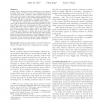Free Online Productivity Tools
i2Speak
i2Symbol
i2OCR
iTex2Img
iWeb2Print
iWeb2Shot
i2Type
iPdf2Split
iPdf2Merge
i2Bopomofo
i2Arabic
i2Style
i2Image
i2PDF
iLatex2Rtf
Sci2ools
PAKDD
2005
ACM
2005
ACM
Dynamic Cluster Formation Using Level Set Methods
Density-based clustering has the advantages for (i) allowing arbitrary shape of cluster and (ii) not requiring the number of clusters as input. However, when clusters touch each other, both the cluster centers and cluster boundaries (as the peaks and valleys of the density distribution) become fuzzy and difficult to determine. In higher dimension, the boundaries become wiggly and over-fitting often occurs. We introduce the notion of cluster intensity function (CIF) which captures the important characteristics of clusters. When clusters are well-separated, CIFs are similar to density functions. But as clusters touch each other, CIFs still clearly reveal cluster centers, cluster boundaries, degree of membership of each data point to the cluster that it belongs, and, whether a certain data point is an outlier or not. Clustering through bump hunting and valley seeking based on these functions are more robust than that based on kernel density functions which are often oscillatory or overs...
Related Content
| Added | 28 Jun 2010 |
| Updated | 28 Jun 2010 |
| Type | Conference |
| Year | 2005 |
| Where | PAKDD |
| Authors | Andy M. Yip, Chris H. Q. Ding, Tony F. Chan |
Comments (0)

